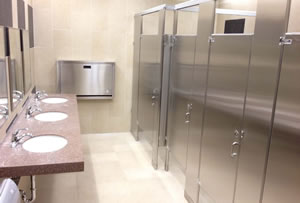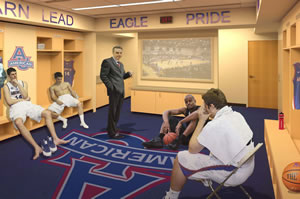Satisfaction in the Restroom (and Locker Room)
 When Aaron Sifuentes, Physical Plant manager at the Roaring Fork Campus of Colorado Mountain College in Glenwood Springs, began renovating restrooms in Quigley Library, he knew he had his work cut out for him. Built in the 1970s, the library is the oldest building on campus, so any work done to it would include bringing it up to ADA code. Plus, to say he had a tight budget would be not be an understatement.
When Aaron Sifuentes, Physical Plant manager at the Roaring Fork Campus of Colorado Mountain College in Glenwood Springs, began renovating restrooms in Quigley Library, he knew he had his work cut out for him. Built in the 1970s, the library is the oldest building on campus, so any work done to it would include bringing it up to ADA code. Plus, to say he had a tight budget would be not be an understatement.
Restroom Renovation
Determined to turn out a project that would please sustainability-minded students and stay within budget, Sifuentes got creative. The bidding process made it clear that it was a labor-only project. “I ran all the purchasing,” he explains. “I was able to avoid the contractor’s markup and acquire all the materials at a tax-free status. That saved thousands of dollars.” His department of 12 also assisted in demolition and haul away, saving even more money. “This enabled us to get the project done on time,” he says, “and allowed me to know what was going on every step of the way.”
On the sustainability side, Sifuentes accomplished a number of things. The bathrooms are small, so the biggest source for sustainability was low-flow water consumption fixtures. “The fixtures I chose for the sinks and soap dispensers are all hands-free,” he says, “so not only is it sanitary, the automatic shut off on the sinks limits the amount of water going down the drain.”
Sifuentes also replaced two-by-four, four-bulb T12 fixtures with LED down cans, which are a fraction of the wattage. “We were at 160-watt consumption per fixture in each bathroom,” he explains. “With three to four fixtures per restroom, we were using 480 to 640 watts of power per bathroom. We’ve cut that by 75 percent.”
Performance Counts
When it comes to budget (pleasing administrators) and sustainability (pleasing students) in restroom and locker room redesign, the two naturally fit together, as evidenced by Sifuentes using low-flow water fixtures. “Sustainability is more than green products or products that are renewable resources,” says Cyrus Boatwalla, director of Marketing for Yonkers, NY-based American Specialties. “It is also about products that have long life cycles. Those products become budget-conscious choices because they require replacing less often and, thus, you’re putting less material in a landfill.”
There’s a third component, says Jeffery Wells, senior product manager at Moen Commercial, North Olmsted, OH. “It’s important to have performance in addition to cost savings and responsibility with natural resources.” For example, the firm recently released a sensor flush valve where, if the piston valve fails, it does so in a closed position so there are no water leaks. He also recommends products that are WaterSense-certified by the EPA.

IMAGE COURTESY OF EYP ARCHITECTURE & ENGINEERING
Locker Room Renovation
These common-sense approaches apply to locker room design as well as restroom design. Let’s look at American University in Washington, DC, which is in the process of renovating locker rooms in its Sports Center. “The Athletics Department was well organized and had a strong vision for what they want to do,” says Sean Lyons, RA, project director and principal with EYP, which has offices in the east, “which is to create dedicated and distinct locker rooms for each sports team.”
In terms of cost savings, the amount of available space was less than what was needed, and the initial budget did not accommodate expansion. So the architects created a space within a space: Two visitor’s locker rooms were joined by an operable wall that, when open, allows the locker rooms to serve as a team conferencing center.
Another cost-saving measure was using a combination of concrete block and drywall, as opposed to all concrete block. “Drywall can be successfully used if a lot of it is covered by lockers and there’s a solid maintenance program,” says Timothy Whitney, AIA, vice president and director of Albany, NY-based CHA Sports, which is partnering with EYP on the project. “Also, graphics go well on a drywall surface and can dramatically change the look and feel of a space without a significant investment.”
“Identifying alternative strategies like this helped keep the project in budget,” says Lyons. Also to ensure staying on budget, a CM at Risk was used to validate cost.
Similar to Sifuentes at Colorado Mountain College, the American University team installed low-flow water fixtures and LED lighting for that eye toward sustainability. In addition, they purchased local and regional materials. And they refurbished functional elements already in place, including cleaning and preserving ductwork.
So Say the Experts
Both of these projects provide many examples for achieving both cost savings and sustainability on locker room and restroom renovation projects. The experts have even more. For example, Boatwalla recommends working with product manufacturers who offer a variety of products so they’re not guiding you to one material type because that’s all they carry.
Harkening back to what was said about purchasing high-performance products, Daniel Depta, manager of Marketing for Special-Lite, Inc., Decatur, MI, suggests ensuring the products chosen are suitable for the environment, conditions and design for which they are intended. “Choosing products for the longest life ensures you get the lowest possible cost,” he says.
Also, for both cost savings and sustainability, Dan Storto, president of Downers Grove, IL-based World Dryer, notes that, “Switching to high-speed hand dryers instead of using paper towels is one simple change that can reduce material costs, maintenance and waste by as much as 90 to 95 percent, as well as reduce the college’s carbon footprint and improve sanitation.” In addition, energy-efficient high-speed hand dryers dry hands in just 10 to 15 seconds — compared to traditional hand dryers that take 30 to 40 seconds — and they use 88 percent less energy than traditional hand dryers.
When it comes to renovating campus restrooms and locker rooms, it is possible to please everyone — budget-minded administrators and sustainability-minded students. It just takes a little creativity and a little planning. And it takes a pay-me-now-or-pay-me-later mindset, as Depta notes: “Consider life-cycle costs, not just first cost, specifying products for performance. Spend smart money, not cheap money.”
This article originally appeared in the College Planning & Management July 2013 issue of Spaces4Learning.